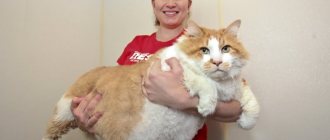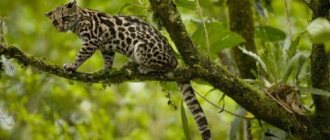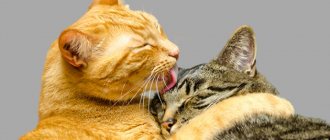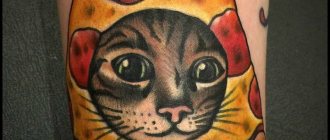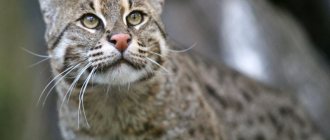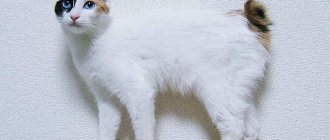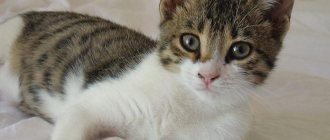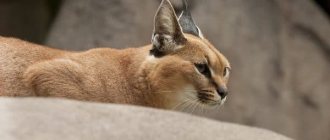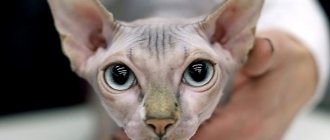Those who love really expensive, elite pets are, of course, familiar with cats of the Bengal breed - this little pet leopard.
However, there is another beautiful cat that has an appearance that imitates a small leopard - this is the Ashera.
This is a very large animal, which was bred in 2006 in the USA by a company that had previously gained notoriety thanks to a fraudulent employee who wanted to make money by selling kittens.
History of the origin of cats of the Ashera breed
The myth called the “Asher cat” has already crossed the ten-year mark. These animals celebrated their anniversary with a rather damaged reputation - the creator of the breed, named Simon Brody, is still wanted, but this does not in any way prevent the company he created from successfully selling pets of this breed.
This story began in 2006 with a truly ambitious statement - the Lifestyle Pets company genetically managed to breed the newest cat breed, big like a dog, beautiful like a wild leopard, and gentle like an ordinary domestic cat.
In addition, these exotics were presented as absolutely non-allergenic animals, very fond of walking on a harness.
It is not difficult to agree that the volume of all the above advantages was enough for clients to start lining up, ready to pay twenty-two thousand dollars for an Asher cat.
Soon after these cats appeared so brightly on the market, an unpleasant moment was the statement of a certain Chris Shirk, who said that the creator of this breed was actually selling Savannah kittens under the guise of an Asher, which he purchased from Shirk.
Brody cited numerous differences between one breed and another, but the courts found him guilty, so today the Asher breed has no official registration.
This is a sad factor, because several photos presented on the Internet clearly show that the Ashera is a magnificent and graceful animal, so many really want these beauties to be part of the vast cat world.
Feeding Asher's cats
global $ads_google;
//data-ad-slot=”2475549904″ $ads_google = empty($ads_google) ? false : true; ?> if ($ads_google == false) {?> $ads_google = true; ?> } ?> The digestive system of the Asher cat is rather weak, so the quality of the food must be the best. Although dry food is convenient for the owner, it is better to replace it with a complete natural balanced diet. This is due to the animal's wild ancestors, who never tried industrial feed. In addition, dry food can provoke the development of urolithiasis, which is not easy to cure.
Experts believe that for the full development and maintenance of the health of expensive spotted cats, industrial food is not enough - Ashera needs minced raw meat of veal, beef and poultry. Pork is considered too fatty for a cat's stomach. Raw sea fish is ideal, but river fish will have to be boiled.
Description of Ashera cats
The Ashera cat is both a luxurious pagan goddess of the same name and an unusual hybrid trio consisting of a common cat, an Asian leopard cat and an African serval.
At least, the unlucky breeder Simon Brody said that it was these animals that gave Ashera its set of genes.
It must be said that there is no officially recognized breed standard for these animals in the world, so only a brief breed description can be given here.
- Small wedge-shaped head.
Eyes can have two shades - green and golden.
The ears closer to the base are quite wide, the ends are rounded and narrow, shaped like small bows.
- Narrow and long body. Extended legs. In general, the body looks somewhat disproportionate. A sexually mature individual can reach a height of one hundred centimeters.
An adult cat weighs approximately twelve kilograms, and a male cat weighs fourteen kilograms.
- The coat is hypoallergenic, short, and adheres well to the skin.
- Colors.
The breed characteristics include four color varieties of these cats:
- Royal Asherah is the rarest variety. Animals with a royal color, that is, golden-orange fur with a small number of spots, only a few individuals appear every year.
- Hypoallergenic Ashera - if you forget that, as a rule, allergies are provoked by cat saliva, and not by fur. The company that bred these cats claims that some varieties of their color contain a record low amount of protein, which makes it possible for Ashers to live in the house of an allergy sufferer.
- Snow Asher, similar to the Belgian tiger, only small in size.
- Common Ashera - spots on the fur make one think of a leopard.
Description and breed standard
The large domestic cat Ashera is striking in its size, being considered the largest in the genus. Here is a table that clearly demonstrates the description of the characteristics and features of a unique species, which is a hybrid of the African serval:
| External data | Characteristic |
| Head | Small, triangular in shape with high-set ears at a short distance, pointed at the tips. The eyes are large and take on either green or gold colors. |
| Body | Proportional, long legs (the hind legs are longer than the front ones), a strong, elongated tail, tapered at the end, well-developed muscles, a wide chest. Fingers on the pads can be elongated or medium length. |
| Wool | Short, elastic, with a soft dense undercoat. |
| Color | Spotted, reminiscent of leopard print. |
Character of cats of the Ashera breed
According to the breeders themselves, that is, those who led the biological project with the help of which the cat of this breed was bred, this animal has an almost angelic character.
She excellently establishes contact with her owners and other household members, and also calmly walks on a harness. In reality, we can say that Ashers almost never show much aggression, but there are situations when their wild nature comes out.
The next advantage of this breed is its hypoallergenicity. Yes, we can say for sure about it, because many tests carried out in a variety of laboratories have confirmed that the fur of an Asher can in no way harm people suffering from an allergic reaction.
The character of these pets is described as friendly and quite obedient; it is noted that Ashers have a great love for outdoor games and mischief, but at the same time they have a somewhat menacing appearance, which they inherited from their distant ancestors.
Ashera character traits
The breeding company in the description of the Asher breed indicates such features as an angelic character and complete obedience. People who own purebred cats agree that their pets do not cause problems. The genes of Ashera's wild ancestors did not manifest themselves in the form of aggression. The cat calmly walks next to the owner on a leash, and feels good on the street.
Asher kittens have a cheerful, playful disposition and love to frolic with their owner and his child. Adult cats are flexible and friendly towards household members. Pets get along well with other animals. It turns out that the cat’s character consists of only advantages.
Despite the serious impressive weight and large dimensions, keeping such cats in the house is not troublesome.
Caring for Ashera cats
And now, you already have almost two million rubles on hand, which you are ready to spend on buying an ashera. Don't rush! First you have to “stand” in line.
The wait lasts approximately nine to twelve months, as Ushers produce no more than one hundred cats each year.
The long-awaited time has come and the kitten you booked is finally born? You will have to pay about another hundred and twenty thousand for delivery and a range of various services.
A mandatory range of services relieves new animal owners from many problems related to the care and maintenance of the cat. It contains:
- microchip for identification;
- certificate from a veterinary clinic;
- insurance policy;
- complete animal care kit;
- transportation equipped with climate control and all other little things;
- additional ten years of consultations with the world's famous doctor Tripp.
All that a person needs, in whose house an Ashera cat will now live, is to come up with a nickname for it and arrange a grand photo shoot in order to show everyone that such pets still exist.
Due to the fact that the main issues relating to the pet’s health are decided by a veterinary certificate, the owner can only occasionally organize water treatments for the cat. There is no need to comb the Asher, because he hardly sheds.
Pros and cons of the breed
Is it worth buying a kitten? Before making a decision, you need to weigh the pros and cons again. The table below will help you understand this.
Table 1. Pros and cons of the Asher breed
| pros | Minuses | |
| 1 | Luxurious appearance of a leopard | Large size, which creates difficulties in maintenance (the need for frequent walks, high food costs) |
| 2 | Kind, gentle disposition, lack of aggression | Tendency to show dominance and independence |
| 3 | Ability to get along easily in a home with small children | Inability and unwillingness to endure loneliness for a long time. The owner cannot afford to travel frequently on vacation or on long business trips. |
| 4 | Easy grooming, painless bathing procedure | The need for a careful approach to diet planning, consultation with a veterinarian |
| 5 | Energetic character, love of games | Frequent damage to furniture due to jumping and other manifestations of increased pet energy |
| 6 | Good health, absence of breed-specific diseases | Weakness of the gastrointestinal tract |
| 7 | Rarity (a large leopard cat is not just a pet, but a real luxury item) | High price |
If the main argument for buying a kitten is prestige, it is better to abandon the idea of having an Asher at home. Today, what makes the breed so unique is not the price, but the combination of its bright appearance, pleasant character and relative ease of care. A leopard cat has every chance of becoming a full-fledged member of the family and a reliable friend.
Reviews of Ashera cats
- Galina.
Regarding the Ashera cat, I can say for sure that the fact that it is called aggressive is complete nonsense. How you raise her is how she will grow up.
If you carry her in your arms throughout her childhood and bottle-feed her, she will turn into a wonderful pet. But I think that an ordinary small apartment is not particularly suitable for such an animal - a spacious house with a plot is needed here.
- Svetlana.
I believe that this breed is exclusively for professionals.
For those who are seriously involved with cats, know everything about breeding and agree to endure many different inconveniences and troubles in order to achieve their cherished goal.
Or, such a cat can be afforded by very rich people who want to show off to others and who have a separate room for the animal, as well as an enclosure for free walking.
You need to understand that most often this is a simple, expensive way for rich people to stand out from the crowd. This is not a house cat or a pet for pleasure, not a pet that can be stroked and held constantly on your lap.
I treat people who buy such cats to show off with skepticism and great disrespect, because no animal deserves such treatment.
- Alina.
One thing can be said about Asher: my family and I are ready to endure everything he does, but I can’t speak for everyone.
The cat marks at any time. Half of the furniture goes to waste. Marks cannot be defeated in any way. He goes to the litter box according to his mood, about once or twice a month. The rest of the time he does his business wherever he pleases.
I think that an Ashera cat is an open-air animal, and can only live in an apartment if it is castrated.
There are, of course, a lot of difficulties.
Ashers smell quite strongly. The smell is difficult to dissipate. As soon as you wash everything, you look - there’s already a mark. Our cat doesn’t like foreign odors, so it’s important for him that everything smells like him.
As for sleeping in the presence of a pet. It's possible, but be careful. Our cat grabbed me by the neck with his entire mouth three times while sleeping.
- Marina.
I live in the USA and I have an Asherah cat. I consider everything bad that many people write about these cats to be complete nonsense.
This is a very affectionate, dog-like, serious and intelligent cat that does all its business exclusively in the litter box. He sleeps in the same bed with us and loves to be cuddled. It is undesirable to punish such an animal.
When I tried to dry my pet with a hairdryer, she scratched me quite badly, she didn’t like it. Insanely beautiful, always greets us at the door, gets sad if she is left at home alone, has an unusual and unique voice, and also starts talking when she hears her name.
It’s just that Ashera is not a cat for everyone, but for people with money, and this must be understood.
- Andrey.
I have an Asherah who is quite small, she is only a little over a year old. This is a magnificent breed, but I can say that it has become difficult to do repairs, the Asher cat is running around the apartment, and a two-room apartment is clearly not enough for him.
He likes to get into the closet and throw everything out of there. Constantly removes curtains from windows. She loves tenderness and gladly allows herself to be stroked. He is friends with my Scottish cat, but still a little jealous. Overall, the pet is cool, but it feels like it has its true wild nature that sometimes breaks through.
Top largest cat breeds
Big cats look graceful and noble, resemble their wild relatives in appearance, have a strong character and force others to take their own opinions into account.
Large breeds appeared thanks to the efforts of felinologists . Some of these cats have retained the character traits of their wild ancestors, while others have a more docile disposition.
Cheeto
The Chito breed was created by crossing Ocicats and Bengals . In 2003, the first kittens were born. American felinologist Carol Drymon worked on developing the breed. The name comes from the English cheetah - and literally translates as “hepa.” The breed is recognized by UFO and received experimental status in TICA.
Cheetos are beautiful animals with velvety fur; they resemble cheetahs in appearance thanks to their rosette-shaped spots. The weight of an adult is 5-6 kg, height is 30 cm . They move quite interestingly - they sneak and bend down to the ground. The character is flexible and peaceful. Thanks to its natural intelligence, the Chito lends itself well to training.
Kurilian and American Bobtail
The Kurilian Bobtail weighs 7-9 kg as an adult . A distinctive feature of the breed is its pom-pom tail, 8 cm long. The first cats arrived on the mainland from the Kuril Islands and quickly joined the list of popular pets. Nature has endowed animals with a multifaceted character. They really don’t like to swim and at the same time they enthusiastically fish. Dog manners combined with feline grace. The breed is considered one of the healthiest. Animals have strong immunity and are not predisposed to genetic diseases.
Kurilian Bobtail
A direct relative of the Kurilian Bobtail is a South American cat with a short tail. The American Bobtail received recognition in 1989, despite the fact that the breed's characteristics were established by felinologists back in the 60s. gg. last century. Representatives of the breed have strong and massive bones and weigh 5-7 kg . The “Americans” have an easy-going character, which makes them favorites of the whole family. In addition, bobtails are comfortable walking on a leash.
American Bobtail
Chartreuse
The Chartreuse or Carthusian cat gained fame back in the 16th century. The breed belongs to the blue French cats. By the way, Charles de Gaulle kept a Cartesian cat at home and doted on it. The breed traces its ancestry to the Chartreuse Mountains, where a Catholic monastery is located. Rumor has it that until the 19th century, the brethren of the monastery prepared a meat stew from Chartreuse. Perhaps this is why the animals lost their voice. These are silent and resigned creatures with an attractive gray coat, amber eyes, weighing 5-7 kg .
Chartreux are undemanding and unpretentious , they look at others with a certain amount of arrogance. Cats are famous for their intelligence and intelligence, flexible nature and loyalty.
Pixie bob
The Pixie Bob is an artificially bred American breed . A distinctive feature is a short tail. Hence the name of the breed. Literally translated, pixie bob means short-tailed elf. The appearance of the cats is complemented by the features of a forest lynx. The breed is very popular in the USA, and the export of animals is prohibited. Representatives of the breed have a distinctive stern lynx appearance and a soft, compliant character. The ears are decorated with funny tassels.
Pixie bob
Norwegian Forest Cat
The thick and voluminous wool of the “Norwegians” is misleading. Cats seem massive, but in fact their weight rarely exceeds 9 kg . The average body weight of an adult is 7 kg.
The breed has been known since the end of the 16th century . It was formed in Norway, a country with a harsh climate. In such conditions, cats acquired thick hair and developed a harsh character. According to legend, the animals arrived in Scandinavia with the Vikings. On ships they caught rats and protected food from spoilage. In Europe, they became domesticated and moved into the homes of peasants. The Norwegians began breeding work in 1934, searching for purebred specimens throughout the country. In 1976, the breed received official recognition.
These cats are strong and resilient and have good health . Fur folds on the neck protect against severe frosts, and strong paws help to move quickly. The Norwegian Forest Cat is famous for its freedom-loving disposition and is suitable for people who value freedom.
British cat
The British Shorthair cat with its plush gray coat is extremely popular. These English aristocrats are endowed with a balanced character, phlegmatic to the point of madness, and prefer solitude. Adults weigh 10-12 kg . Often this figure increases due to a great love for food.
If you don't watch your diet , the British will grow into a furry bun and become the fattest breed of cats. The eyes of the British are an amazing copper color, they are favorably set off by a bluish-gray fur coat.
Turkish van
Another name for the breed is the Turkish Van cat. These animals are native to the area around Turkey's southeastern Lake Van. Representatives of the breed were worth their weight in gold in their homeland and until the 70s. In the 20th century, the export of animals outside of Turkey was prohibited. Large cats of the Van breed are considered one of the rarest in the world. Adult individuals weigh 7-10 kg, the length of the body together with the tail reaches 1.2 m .
The Turkish Van is a cat with a complex, freedom-loving character , who is too cramped within the walls of a city apartment. In order for the animal to feel comfortable, it is important to provide it with the opportunity to roam freely. Cats love water; they can sit and admire the surface of the water for hours, and will not miss the opportunity to swim.
Siberian cat
The Siberian cat is large, serious, with a strong hunting instinct and hypoallergenic coat . Distinctive features of the breed are a variety of colors, long thick hair, a fluffy tail, a muscular body and massive bones.
The weight of adult individuals reaches 12 kg . “Siberians” are very active, they will not lie down on the couch. Instead, they will rush headlong around the apartment, chasing a toy mouse or ball. These cats have a high IQ, they are strong and resilient, and have lightning-fast reactions. The Siberian cat is also a hunter; she can even bring home a hare.
Interesting. Representatives of the breed get along well with children, but will not miss the opportunity to express their leadership to other cats and even dogs.
Ragamuffin
Ragamuffin is a Californian “ragamuffin”, as he is called in his homeland. The breed was developed by the American Anne Baker, who decided to add the features of the Himalayan and Persian cats to the ragdoll. , large cats weighing 10 kg were born .
They are distinguished by their awkward physique, which, however, does not interfere with leading an active lifestyle. The colors of the large purebred cat are varied, the coat is thick and shiny . Character is playful and friendly. The cats are not aggressive at all and get along with all family members.
Ragdoll
The Ragdoll is a massive cat with strong paws and medium-length hair . Translated, the name of the breed sounds like “rag doll.” When you first meet ragdoll, it becomes clear where the name comes from. In your arms, the cat goes limp and seems to spread out. This is an ideal cat for families with children. Animals allow you to do whatever you want to them, and will never scratch a child.
The weight of adult cats is 10 kg . The calling card of the breed is the blue iris.
Housey
Other names for the breed are Chausie, Shawsie. The animals combine the appearance of a wild predator and the affectionate disposition of a domestic cat. Breeders crossed the Abyssinian cat and the jungle cat and introduced the new breed to the world in 1990. These cats are quite large, weigh 14-15 kg , have natural grace and a peaceful character. Short hair does not require special care.
Housey (chausie, shawzy)
Maine Coon
The Maine Coon is a native breed that originated from cats living on the farms of Maine. The literal translation of the breed's name is “Manx raccoon” due to its resemblance to these animals. Maine Coons are large cats, weighing 15 kg, length 40 cm . The largest cat in the world, the breed reaches its maximum size by 3-5 years. The breed is considered one of the largest after the Asherah.
These cats are peaceful and affectionate, loving their owners madly . Males are excellent fathers and raise their offspring equally with females. Maine Coons love to interact with people and be the center of attention. But at the same time, they are extremely delicate and will not impose themselves, much less get under your feet.
Savannah
Savannah or Asherah is the largest breed of cat, a domestic leopard, weighing 15-20 kg and 60 cm tall . The nature of the animals is in many ways similar to that of a dog. They are smart, quick-witted, have lightning-fast reactions, and are easy to train. And this is not surprising, because the savannah is a direct descendant of the African serval and bengal.
Animals are agile, capable of surprising the length of their jumps . The striking appearance is complemented by the high cost of the breed, ranging from 3 to 25 thousand US dollars. The Ashera's coat is short, spotted, and its eyes are of amazing beauty - a sandy-green hue. The character of the largest breed of cats is calm and peaceful. Savannah is a very curious cat and loves to be aware of all the events in the house.
Reference. Ashera's developed intelligence allows her to avoid conflicts with other animals.
Ashera cat price. Where to buy an Asher cat. Asher's nurseries
You can buy a small kitten of the Asher breed today. You just need to visit the official portal of the company that released these animals.
But, remember that the queue for such elite kittens is very long, since no more than one hundred individuals are sold annually, and the price for an Asher is increasing more and more. Therefore, those who want to get such a pet will definitely have to wait. These cats cost a lot of money.
The price of representatives of the Asher breed ranges from twenty to thirty thousand dollars per kitten; its specific size is influenced by the gender of the animal and the purpose of purchase.
This means that the price in rubles will reach one and a half million. Today, Ashers are already sold for breeding, and naturally, such individuals will cost an even higher price.
Characteristics and features of Ashera
Today you can still find an offer for the sale of a “divine cat,” but honest breeders will definitely indicate that this is a Savannah F1, that is, a first-generation hybrid obtained from a wild serval.
The descriptions of these animals are very similar. Distinctive features of the cat named after the mother of all gods:
- Large sizes - body length is about one hundred centimeters and approximately the same height.
- The weight of an adult is up to fifteen kilograms.
- The coat is short, without undercoat, lying close to the body. A distinctive feature of the Bengal, which participated in the development of the new hybrid, is the extraordinary quality of the coat - glitter, shine and silkiness.
- The declared hypoallergenicity is also borrowed from the Bengal cat. Zero undercoat means no shedding. Saliva contains a component characteristic of cats to a much lesser extent. Read the article about hypoallergenic cats.
- The newcomer had three main colors.
- The rarest is royal - almost orange with a slightly darker spot. There are only a few such animals.
- No less original - snowy with a dark spot, snow leopard color.
- Common for Bengals is gold with a black spot.
- The head is characteristic of a serval, small in relation to the body, wedge-shaped, tapering towards the chin.
- The ears are long, wide at the base, tapering at the top. On the back surface of the ear are white “eyes” characteristic of wild cats. It is believed that these light spots help guide the brood following its mother in the dark.
- The eyes are large, almond-shaped, slightly raised to the ears at the outer corners. Color - green or golden topaz.
- The legs are high, muscular, dry, the hind legs are much longer than the front ones. This structure of the limbs is characteristic of the serval.
- The body of an athlete is strong, with well-developed muscles, long and elongated.
Health and feeding of Ashera cats
Asher breeders often say that she has a rather weak digestive system.
In order for various stomach problems not to turn into big troubles left on the floor and carpets, the cat must eat high-quality and nutritious food.
Ashera should not be offered dry ready-made food, even the highest quality, as the main feeding.
No, dry food is not completely prohibited in this case; it is allowed as a food additive, but the main source of all necessary substances, elements, vitamins and minerals should be balanced natural food.
Proximity to wild cats determines the content of such a pet’s menu: fresh beef, poultry, sea fish - this is the first, second, third and dessert for this cat. Before serving meat to a cat, it must be frozen for three days, and then doused with boiling water.
Important aspect! Between minced meat and minced meat, it is worth giving preference to the first option so that the Asherah’s stomach has the opportunity to function well.
Yes, there are many nuances, but basically you still need the banal set of any pet lover - love, tenderness and attention to your pet.
Although, it is impossible to hurt or unpleasant a cat as beautiful as the Ushers in the photos presented, because this is the real pride and joy of the owner.
Keeping a pet
Rumors about some special difficulties in keeping a hybrid breed are greatly exaggerated. Savannah care is quite simple and not burdensome. The food for this cat is not too expensive, but it needs to be organized correctly.
The right diet is the main thing in maintaining a savannah
Feeding
A properly selected diet is the most important component of health for a cat of this breed. A weak stomach and sensitive digestion are the animal’s weak point. Even the highest quality freeze-dried food is not the best option for feeding the savannah. She needs natural protein nutrition, 90% consisting of fresh raw meat and sea fish. River fish should not be on the menu - it has too many bones. Sweets, including overly sweet fruits, are also harmful to cats; foods with a high starch content are also not suitable for them.
The basis of the savannah diet is meat and fish.
Do not give your pet too large portions - meals should be fractional, divided into several meals. It is recommended to pre-package the food into separate bags and keep each one in the freezer for at least three days, and immediately before feeding, pour boiling water over it.
Periodic visits to the veterinarian are highly recommended; thanks to his consultations, you will be able to optimally balance the cat’s menu and introduce mineral and vitamin supplements in the required dosage.
Appearance care
Savannahs do not require any specific, overly complex care for their coat and other aspects of their appearance. It is enough to comb it weekly with a soft powder brush and regularly monitor the condition of the ears, eyes and teeth.
Savannah wool does not require complex care
There is no point in specially arranging bath procedures for your cat - just let her splash around in warm, clean water - Savannahs love it. But cold water, and especially drafts, are very dangerous for the health of the animal, this should always be remembered.
Ashera cat. Photo
Record size
For a long time, the records for the size of domestic cats were held by representatives of the Maine Coon . They are also called:
- Maine cats;
- Maine raccoons.
This is due to the fact that the first cats of this breed were externally of a characteristic color - black tabby. Adults can reach a weight of 10 kg, and are similar in appearance to their wild forest relatives. The characteristic tufts on the ears and the structure of the skull will not allow the Maine Coon to be confused with any other breed, and their majesty and look visually increase the real dimensions of the representatives of the breed.
Today the largest Maine Coon lives in Australia . The cat named Rupert is 3 years old and already weighs about 9 kg. It will seem to many that such a weight is within the acceptable range for the breed and there is nothing special about it, but Maine Coons gain weight for more than one year. Most likely, the pet will increase its weight by half over the next few years, which brings it significantly closer to the record, and this is without progress towards obesity. The fact is that the impressive size of Rupert's cat is just a natural constitution and well-developed muscle mass.
Feeding the large domestic cat Ashera
These cats must have meat on their menu. It does not have to be cooked; you can feed it raw meat. The meat should be lean; rabbit, veal or chicken are perfect. It is better not to give your cat fish; the same applies to milk. Experienced breeders advise contacting a veterinarian for a feeding schedule for the animal. It is recommended that cats be given an additional vitamin complex containing taurine. You can feed dry food, but do not neglect fresh food.
Hereditary diseases and health
Even though the cats were bred in a laboratory, this did not rid them of diseases. Cats enjoy good health and live up to 20 years. A few diseases of the breed include polydactyly, hydrocephalus, dwarfism, and cleft palate. Sometimes animals are susceptible to bacterial, viral or fungal infections. A sick cat becomes lethargic and less interested.
